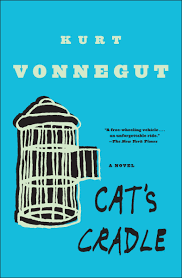Cat’s Cradle by Kurt Vonnegut

Summary of Cat’s Cradle:
Told with deadpan humour & bitter irony, Kurt Vonnegut’s cult tale of global destruction preys on our deepest fears of witnessing Armageddon &, worse still, surviving it …
Dr Felix Hoenikker, one of the founding ‘fathers’ of the atomic bomb, has left a deadly legacy to the world. For he’s the inventor of ‘ice-nine’, a lethal chemical capable of freezing the entire planet. The search for its whereabouts leads to Hoenikker’s three ecentric children, to a crazed dictator in the Caribbean, to madness. Felix Hoenikker’s Death Wish comes true when his last, fatal gift to humankind brings about the end, that for all of us, is nigh…
“It is never a mistake to say good-bye.” – KV
My Take, Why its worth a read:
It’s a short quick read that really gets you thinking. Vonnegut uses Cat’s Cradle to discuss (in a rather funny and biting satire way) issues like religion, politics and the possibility of humanity managing to destroy the world. He creates his own religion in the book to show us just how much power we give up to dogma and tradition. How people can be taught to believe anything if there is cause for it. Through the main character John, you will find yourself re-examining a lot of things that are now “normal” parts of our world.
Favorite Quote:
“Life is a garden, not a road. We enter and exit through the same gate. Wandering, where we go matters less than what we notice.”
About the Author:
Kurt Vonnegut, Junior was an American novelist, satirist, and most recently, graphic artist. He was recognized as New York State Author for 2001-2003.
He was born in Indianapolis, later the setting for many of his novels. He attended Cornell University from 1941 to 1943, where he wrote a column for the student paper, the Cornell Daily Sun. Vonnegut trained as a chemist and worked as a journalist before joining the U.S. Army and serving in WW II.
After the war, he attended University of Chicago as a graduate student in anthropology and also worked as a police reporter at the City News Bureau of Chicago. He left Chicago to work in Schenectady, New York in public relations for General Electric. He attributed his writing style to his reporting work.
His experiences as an advance scout in the Battle of the Bulge, and in particular his witnessing of the bombing of Dresden, Germany whilst a prisoner of war, would inform much of his work.Vonnegut was a self-proclaimed humanist and socialist (influenced by the style of Indiana’s own Eugene V. Debs) and a lifelong supporter of the American Civil Liberties Union. The novelist is known for works blending satire, black comedy and science fiction, such as Slaughterhouse-Five (1969), Cat’s Cradle (1963), and Breakfast of Champions (1973



Muito Grata pelo post.
Where is that quote from? I’ve searched through copies of the book online and cannot find it in its pages
Same question as Johnny Walker above: where is the quote from? Because my edition of the book doesn’t have it!